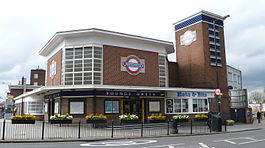Bounds Green Underground station
| Bounds Green |
|
|---|---|

Station entrance
|
|
| Location | Bounds Green |
| Local authority | London Borough of Haringey |
| Managed by | London Underground |
| Number of platforms | 2 |
| Fare zone | 3 and 4 |
| OSI | Bowes Park |
| London Underground annual entry and exit | |
| 2013 |
|
| 2014 |
|
| 2015 |
|
| 2016 |
|
| Railway companies | |
| Original company | London Electric Railway |
| Key dates | |
| 19 September 1932 | Station opened |
| Listed status | |
| Listing grade | II |
| Entry number | 1393641 |
| Added to list | 19 January 2010 |
| Other information | |
| Lists of stations | |
| External links | |
| WGS84 | 51°36′25″N 0°07′27″W / 51.60694°N 0.12417°WCoordinates: 51°36′25″N 0°07′27″W / 51.60694°N 0.12417°W |
|
|
|
Bounds Green is a London Underground station, located at the junction of Bounds Green Road and Brownlow Road in Bounds Green in the London Borough of Haringey, North London. The station is on the Piccadilly line, between Wood Green and Arnos Grove, and is on the boundary between Zone 3 and Zone 4.
Like all stations on the Cockfosters extension, Bounds Green, which opened on 19 September 1932, set new aesthetic standards not previously seen on London's Underground. During the planning period of the extension to Cockfosters, alternate names for this station, "Wood Green North" and "Brownlow Road" were considered but rejected.
The station was used as an air-raid shelter and people slept on the stairs between the escalators here as well as on the platforms. On the night of 13 October 1940, during The Blitz, a lone German aircraft dropped a single bomb on houses to the north of the station. The destruction of the houses caused the north end of the westbound platform tunnel to collapse, killing or injuring many people amongst those sheltering from the air raid. The train service was disrupted for two months.
A memorial plaque (placed in the station in 1994, at the north end of the westbound platform) erroneously commemorates "sixteen Belgian refugees and ... three British citizens who died" in the attack. The records of the civilian deaths held by the Commonwealth War Graves Commission indicate that in fact sixteen people died at the scene – only three of whom were Belgian – with a seventeenth dying in hospital the following day. Approximately twenty people were injured, but survived.
Architecturally, this tube station, designed in the typical "Box-style" of the architect Charles Holden by his colleague C. H. James, is a well-preserved example of the modernist house style of London Transport in the 1930s. The octagonal frontage is flanked by a ventilation tower. The octagonal ticket hall is lit by four large windows with an imposing lattice of concrete beams in the ceiling; large London Underground roundels; and original bronze signs, ventilation grilles and information panel frames. The sub-surface areas of the station are finished in biscuit-coloured tiles lined with red friezes. Holden's designs emphasised functionality combined with balanced geometry and the use of modern materials, especially glass and reinforced concrete. The historical significance of the station is emphasised by its involvement in the World War II blitz.
...
Wikipedia

